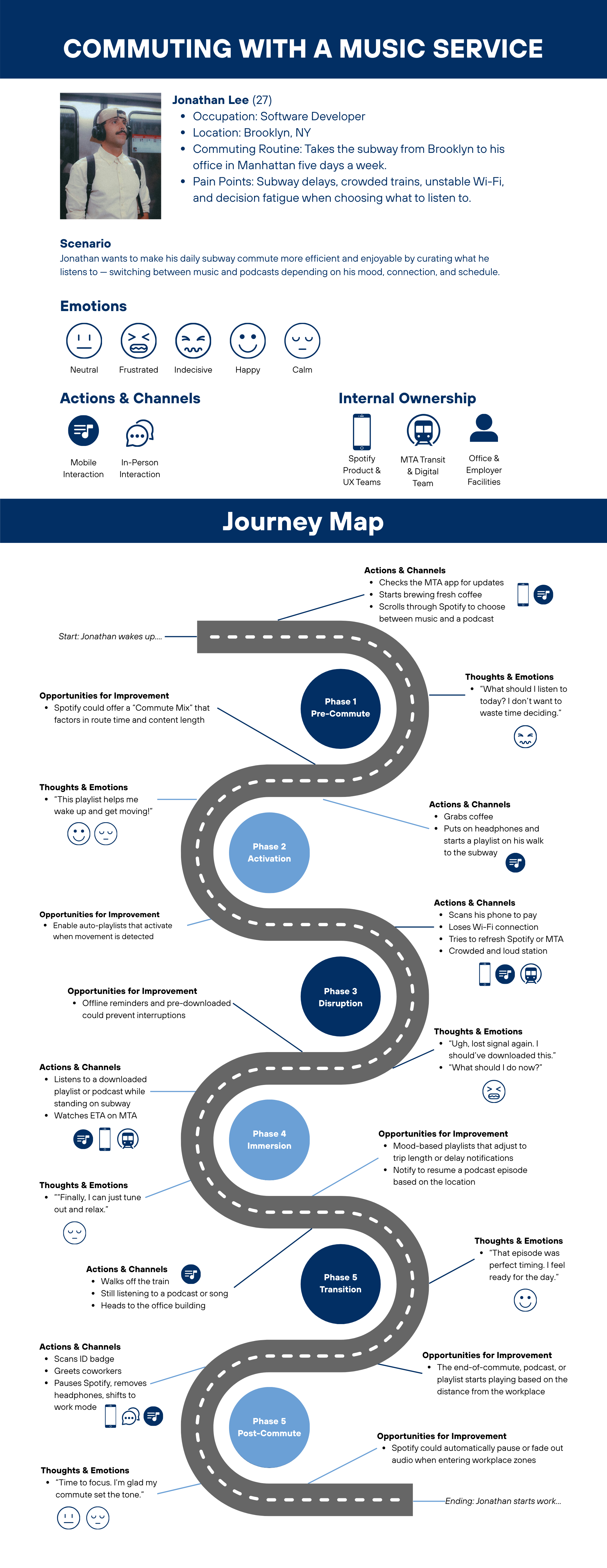From Chaos to Calm: Mapping a User’s Morning Commute
Journey mapping is a visual method that helps designers understand the experiences people have as they interact with a product or service. It’s more than a chart—it captures emotions, pain points, and opportunities along the way. I created a journey map around Jonathan Lee, a 27-year-old software developer from Brooklyn, who commutes daily to Manhattan. His morning routine blends two constants in city life: public transit and music.
Jonathan’s goal is simple—make his commute more efficient and enjoyable by curating what he listens to. Whether it’s music to boost energy or a podcast to stay informed, his experience represents how technology and music shape our everyday habits and moods.
The Phases of the Journey
Jonathan’s morning unfolds in a series of small but meaningful moments that shape his overall experience. Each phase highlights a different interaction between his environment, technology, and mindset.
Pre-Commute: The day begins at home, as Jonathan checks transportation schedules, scrolls through Spotify, and mentally prepares for the day.
Activation: With coffee in hand, he starts the walk, putting on headphones, and building momentum with music.
Disruption: Upon entering the station, the flow breaks—he pays the fare, loses Wi-Fi, and deals with the inevitable uncertainty of crowded platforms or delayed trains (common commute stress points).
Immersion: Once settled in, Jonathan tunes into a new playlist or podcast, shifting to a calmer, focused headspace.
Transition: Walking from the station to the office, he is wrapping up the playlist or episode.
Post-Commute: Finally, Jonathan enters his workplace, pauses Spotify, greets coworkers, and shifts to a professional mindset.
These six stages demonstrate the impact that small technological features—such as automatic downloads or adaptive playlists—can have on smoothing transitions throughout the journey.
Touchpoints: Actions and Channels
Jonathan’s journey includes a blend of mobile and in-person touchpoints. His day begins by checking the MTA app for updates while brewing coffee, then scrolling through Spotify to choose between playlists and podcasts.
Once outside, his interactions shift between physical and digital: paying his subway fare through his phone, managing connection problems underground, and using Spotify’s offline mode when Wi-Fi cuts out. Upon arriving, he walks to his office while finishing a podcast episode, then scans his ID badge and pauses the audio as he transitions into work mode.
These touchpoints reveal how seamlessly users switch between devices, environments, and mindsets, making reliability and convenience critical in any commuting experience.
Emotions: The Commuting Rollercoaster
Jonathan’s emotional state... His day begins with grogginess and indecision—“What should I listen to today?”—followed by motivation once he starts a playlist on his walk to the subway. The low point comes when Wi-Fi drops or delays occur, creating frustration and impatience.
However, the moment he settles into the train and listens offline, his mood improves dramatically. This quiet time offers calm and mental focus before the workday begins. By the time he reaches his office, his emotions stabilize. Jonathan now feels prepared and ready to engage.
Opportunities for Improvement
Jonathan’s experience exposes key opportunities for design innovation. A “Commute Mode” in Spotify could automatically suggest playlists or podcasts based on route length, connectivity, and time of day. Offline download reminders would reduce frustration from signal loss, and mood-based audio recommendations could match the tone of his morning. Integrating Spotify with MTA data could even align listening experiences with estimated travel times or delays.
The Takeaway
Journey mapping turns everyday routines into valuable research. By visualizing Jonathan’s commute, I was able to see how emotional highs and lows connect directly to product design. This process reinforces the importance of empathy—understanding how even minor inconveniences, like losing Wi-Fi, can disrupt a user’s sense of flow. When designers consider the full emotional picture of a user’s day, they create experiences that feel seamless, human, and meaningful.
Jonathan Lee’s Journey Map





